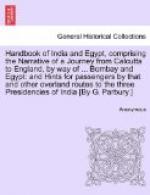A Rangari betrothal though simple enough in itself contains certain elements of interest. The father of the bridegroom usually informs the Patel of the caste that his son’s betrothal will take place on a certain day, and on the evening of that day the bridegroom’s retinue, accompanied by the Patel and various friends and relations, journeys to the house of the bride. After the company has fully assembled someone brings forward a cocoanut on a tray with a few copper coins beside it. The Patel then asks why the cocoanut has been brought, to which one of the bride’s supporters replies “It is for the betrothal of the daughter of Zeid with Omar.” This feature of the ceremony is obviously of Hindu origin and must be a legacy of the days when the Rangaris, not yet converted to Islam, belonged to the Hindu Khatri or Kshattriya caste of Gujarat and Cutch. For the loose copper coins, which till recently were styled “dharam-paisa,” must be lingering remnants of the Brahman “dakshina,” which always accompanied the “shripal” or auspicious fruit; while among Hindus from the very earliest ages cocoanuts have been sent by the bride to the bridegroom, sometimes as earnest of an offer of marriage, sometimes in token of acceptance. After this ceremony is complete the parties cannot retract, the ceremony being considered equivalent to a “nikah” or actual registration by the Kazi; and this fact again discovers the Hindu origin of the Mahomedan Rangaris and of their customs, for among foreign Musulmans the betrothal is a mere period of probation and is terminable at the desire of either party. The “dharam-paisa” usually finds its way into the pocket of the street-Mulla, who has a room in the neighbouring mosque and is charged with the circulation of invitations to all members of the Rangari jamat to assemble at the bride-groom’s house for the betrothal-ceremony.




